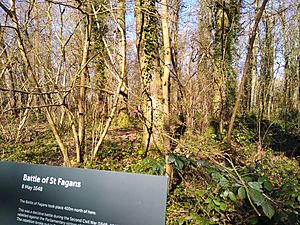Battle of St Fagans facts for kids
Quick facts for kids Battle of St Fagans |
|||||||
|---|---|---|---|---|---|---|---|
| Part of the Second English Civil War | |||||||
 Royalist commander and former Parliamentarian, Rowland Laugharne |
|||||||
|
|||||||
| Belligerents | |||||||
| Commanders and leaders | |||||||
| Gen. Rowland Laugharne Col. John Poyer Col. Rice Powell |
Col. Thomas Horton | ||||||
| Strength | |||||||
| 7,500 infantry 500 cavalry |
900 horse 800 dragoons 1,000 foot |
||||||
| Casualties and losses | |||||||
| 200+ killed 3,000+ captured |
Unknown | ||||||
The Battle of St Fagans happened near the village of St Fagans in South Glamorgan, Wales. It took place on 8 May 1648 during the Second English Civil War. In this battle, a group of soldiers from the New Model Army defeated a Royalist force. Many of the Royalist soldiers were actually former Parliamentarian soldiers who had rebelled. This victory mostly ended the strong Royalist fighting in Wales.
Contents
Why the Battle Happened
Wales and the English Civil War
Wales was a very important area for Parliament. This was because most of Wales had supported the Royalists during the First English Civil War. Parliament worried even more when they found messages from Irish groups. These messages offered help to King Charles I.
If the Royalists controlled places like Cardiff and Milford Haven, they could bring soldiers from Ireland to England. At the same time, the leaders of the New Model Army didn't trust local commanders. These commanders included John Poyer and Rowland Laugharne. The New Model Army thought they might secretly support Parliament's enemies. So, in July, Colonel Thomas Horton was sent to Wales. He brought about 3,000 men to replace Laugharne and secure these important areas.
The Start of the Rebellion
The rebellion began in Pembrokeshire, an area Parliament had controlled since 1643. Like the New Model Army soldiers, these soldiers hadn't been paid for months. They were also afraid of being sent home without their wages. In early March 1648, two commanders, Poyer and Rice Powell, refused to give up their castles. Poyer was the Governor of Pembroke Castle, and Powell held Tenby Castle. Laugharne supported their refusal.
What started as a fight about soldiers not getting paid soon became a political rebellion. The rebellious Parliamentarian soldiers contacted King Charles I. Most Royalists who had fought before were released after promising not to fight Parliament again. So, they didn't join this new rebellion. One exception was Sir Nicholas Kemeys, who held Chepstow Castle for the king. By the end of April, Laugharne had gathered about 8,000 troops. He was marching towards Cardiff.
Horton first moved to Carmarthen. Then he had to stop an uprising in Brecon. After that, he took over Cardiff and set up his troops in and around St Fagans, west of the town. Laugharne learned that more soldiers, led by Oliver Cromwell, were coming. So, he decided to attack Horton before they could arrive. Horton's 3,000 soldiers were outnumbered. However, many of the 8,000 rebels weren't well-trained. Horton's experienced soldiers were much better fighters.
The Battle of St Fagans
A small stream called the Nant Dowlais separated the two armies. Early in the morning, Laugharne sent 500 foot soldiers across the stream. They attacked Horton's center, hoping to surprise the Parliamentarians in the village. But Horton's cavalry (horse soldiers) quickly charged and forced this advance group to retreat. This allowed the Parliamentarians to get ready for battle in the open field.
The main battle then began in the open area northwest of the village. In the middle, tall hedges made it hard for Horton's horsemen to move. But Okey's dragoons (soldiers who rode horses but fought on foot) pushed back both sides of the Royalist army. Finally, Parliamentarian horsemen, led by Major Bethel, were able to attack the Royalists from the side and behind. The Royalists got scared and ran away. More than 200 of Laugharne's men were killed, and another 3,000 were captured.
People say the river Ely ran red with blood, but that's probably an exaggeration. Even so, the experienced Parliamentarian soldiers, especially their horsemen, were able to defeat the Royalists, even though the Royalists had more soldiers.
What Happened Next
Laugharne retreated with the rest of his army to join Poyer at Pembroke. Meanwhile, Horton surrounded Rice Powell in Tenby Castle. Cromwell reached Gloucester on the same day as the battle. He then crossed into Wales shortly after. Colonel Isaac Ewer and a small group of soldiers were left to surround Chepstow Castle. Cromwell joined Horton at Tenby on 15 May. Leaving Horton with enough men to deal with Powell, Cromwell marched the rest of his army to surround Pembroke.
When these castles fell, Cromwell was able to march back into England. He then defeated an invading Scottish army at the important Battle of Preston. Dealing with Laugharne had delayed Cromwell quite a bit. However, he would have been delayed even more if Laugharne's army hadn't been mostly destroyed at St Fagans.


